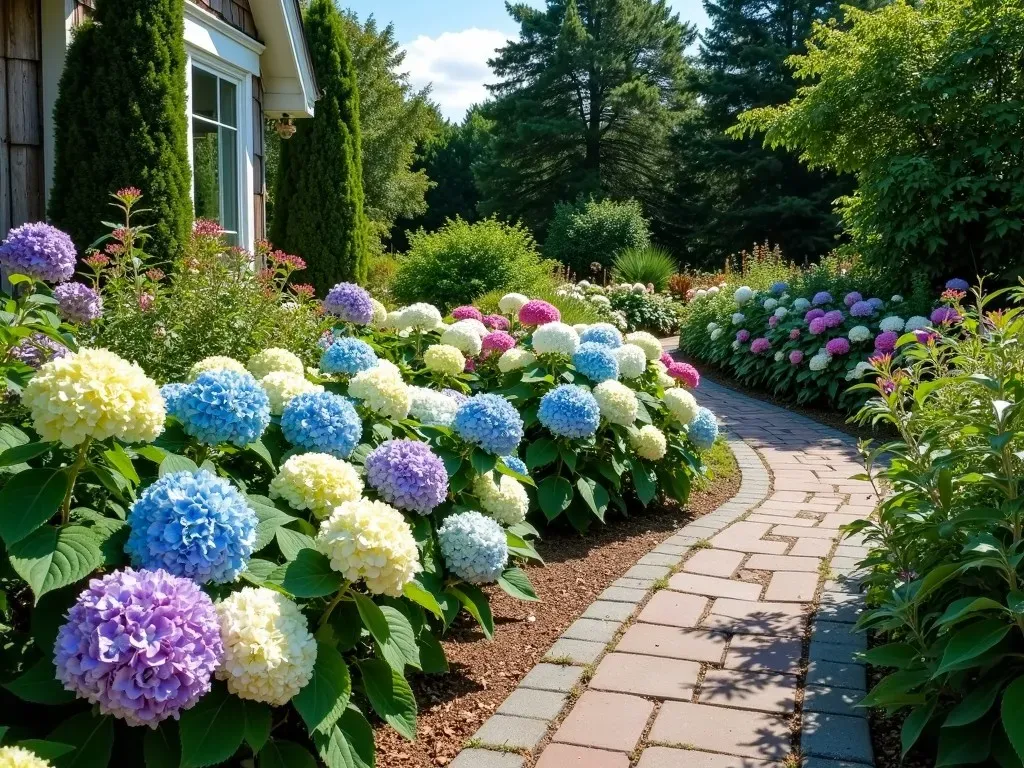Hydrangea border ideas are a perfect way to create stunning landscapes, providing an array of colors, textures, and seasonal interest for your garden. With their vibrant blooms and lush foliage, hydrangeas can easily brighten up any border, walkway, or hedge, making them a favorite among gardeners.
The Versatility of Hydrangea Borders
Hydrangeas come in a variety of species and hybrids, each offering unique sizes, shapes, and colors. These features make them suitable for multiple uses such as:
- Borders: Create defined edges for beds and pathways.
- Hedges: Use as a natural privacy screen.
- Woodland Gardens: Add beauty and charm in shaded areas.
- Walkways: Frame paths with flowering hydrangeas.
Table: Common Hydrangea Varieties and Their Characteristics
| Variety | Height | Bloom Color | Sun Requirement | Unique Trait |
|---|---|---|---|---|
| hydrangea macrophylla (Bigleaf) | 3-6 feet | Pink, Blue | Part shade to full sun | Color changes based on soil pH |
| Hydrangea paniculata (Panicle) | 3-10 feet | White, Pink | Full sun to part shade | Cone-shaped flower clusters |
| Hydrangea arborescens (Smooth) | 3-5 feet | White | Full sun to part shade | Hardy and blooms on new wood |
| Hydrangea quercifolia (Oakleaf) | 3-8 feet | White | Part shade | Unique oak-like leaves; great fall color |
| Hydrangea serrata (Mountain) | 2-4 feet | Blue, Pink | Part shade | Compact size, good for small gardens |
Planning Your Hydrangea Border
Creating a hydrangea border involves thoughtful planning to ensure that the right varieties are selected and placed in optimal locations. Here are a few steps to consider:
-
Choose the Right Space: Identify where the border will be placed in relation to sun exposure and surrounding plants.
-
Select Hydrangea Varieties: Opt for varieties based on your preferences for color, height, and blooming season.
-
Plan for Seasonal Interest: Incorporate a mix of early, mid, and late-blooming hydrangeas to maintain visual appeal throughout the year.
Hydrangea Walkways and Edge Borders
For walkways, consider planting hydrangeas along the sides to frame the path. Here are some ideas to maximize impact:
-
Layering: Use tall varieties like Hydrangea paniculata at the back and shorter ones like Hydrangea macrophylla at the front for a layered effect.
-
Symmetry and Balance: Place hydrangeas in a symmetrical pattern for a formal look or a staggered layout for a more relaxed style.
-
Companion Planting: Add complementary plants like hostas or ferns to enrich texture and color.
List: Companion Plants for Hydrangeas
- Hostas
- Ferns
- Astilbe
- Coral Bells
- Japanese Forest Grass
Using Hydrangeas in Hedge Formations
If you’re considering using hydrangeas as hedges, hydrangea macrophylla and hydrangea paniculata are ideal choices due to their robust growth and dense foliage. Here’s how to effectively plant a hydrangea hedge:
-
Spacing: Space bushes 3-4 feet apart depending on the grown size of the plants.
-
Maintenance: Regular pruning after blooming will ensure healthy growth and promote larger blooms.
-
Color Scheme: Choose a color palette that complements your home’s exterior.
Creating a Four-Season Hydrangea Border
To keep your garden beautiful year-round, select hydrangeas that offer various seasonal benefits.
-
Spring: New foliage appears, and some varieties will begin blooming.
-
Summer: Vibrant clusters of flowers bloom, attracting pollinators.
-
Autumn: Foliage may change to beautiful hues of red, orange, or yellow.
-
Winter: Hydrangea seed heads provide structure and interest when covered with snow.
Website for Reference: Garden Gate Magazine: Four-Season Hydrangea Border
Must-Have Tips for Hydrangea Lovers
-
Soil Chemistry: Test and amend your soil; hydrangeas’ bloom colors can change based on soil acidity.
-
Watering: Ensure consistent moisture, especially during dry spells to ensure the blooms remain vibrant.
-
Fertilization: Use a balanced fertilizer during the active growing season to enhance growth and blooms.
-
Pruning: Familiarize yourself with the pruning needs of your selected variety to encourage lush foliage and abundant flowers.
FAQs About Hydrangea Borders
Q: How much sun do hydrangeas need?
A: Most hydrangeas thrive in part shade; however, certain varieties like Hydrangea paniculata prefer full sun.
Q: Can I mix different types of hydrangeas in a border?
A: Yes, mixing different types can create a visually dynamic border but be mindful of their growth requirements and mature sizes.
Q: Do hydrangeas attract pests?
A: Hydrangeas are generally resistant to common pests, but keep an eye out for aphids or spider mites.
Q: When is the best time to plant hydrangeas?
A: Spring and fall are ideal for planting hydrangeas, allowing the plants to establish before the heat or frost sets in.
Q: Can I grow hydrangeas in pots?
A: Yes, many varieties can thrive in containers. Ensure they are large enough to accommodate root growth and have adequate drainage.

Incorporating hydrangeas into your garden


